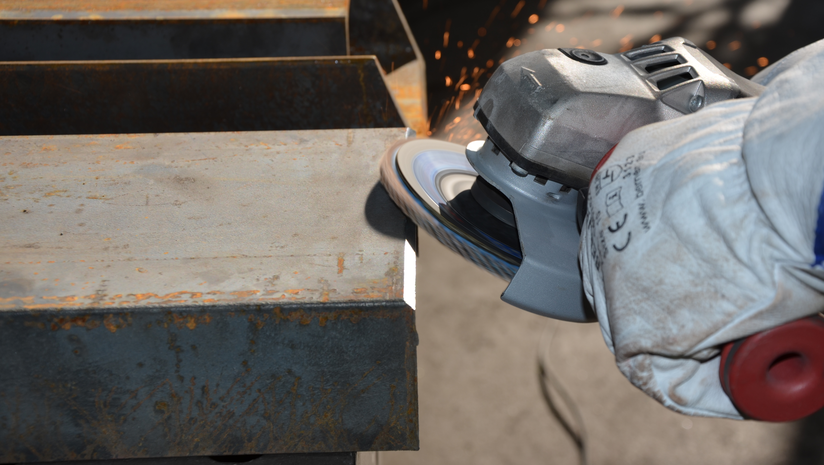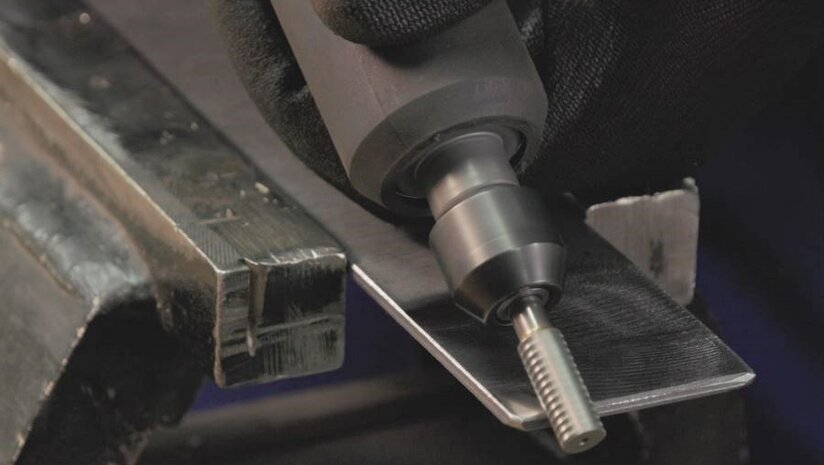
Beveling
If two workpieces are to be welded together, the edge of the workpieces must first be broken by a beveled surface. This is done by machining. The result is a chamfer, also known as a bevel.
What is beveling and
why is it important?
If two workpieces are to be welded together, the edge of the workpieces must first be broken by a beveled surface. This is done by machining. Or in other words, a space is created to accommodate the individual welding layers through which the workpieces are joined together. The bevel can have different shapes. The V-joint, the double V-joint, and the Y-joint are the most common shapes.
Which tool is used for beveling?
The position of the weld, the material of the workpiece, and the types of drives available - the choice of the right tool depends on various factors.
If an angle grinder is available, the beveling can be done with sulfur- and iron-free Osborn flap discs. Flap discs with a conical or straight shape are available. The angle on the workpiece determines the shape of the flap wheel.
If a workpiece made of non-ferrous metal is to be beveled, we recommend an abrasive cloth with a cooling bond as it reduces blue tarnish.

Pictured: Beveling with an Osborn flap disc.
If a straight grinder or air grinder is available, chamfering can be done with carbide burrs. The milling head is made of tungsten carbide-cobalt, the shank of tool steel. Different head shapes and toothings ensure that there is the right solution for every application.
For chamfering, burrs with cross serration (Z6) are the best choice. It ensures high stock removal in a short time. If the surface quality is important, a single tooth (Z3) is recommended. In the shipyard sector, the special shipyard toothing is often used. Compared to the Z6 toothing, it has a 30% higher material removal rate.

Camfering with a carbide burr.
Products for
Beveling.

Horsehair Tin Ferrule Acid Brush
Ideal for use with acid, lubricant, and glue. Tin ferrule design prevents bristles from loosening for longevity.

ATB™ Miniature Cup Brush
Featuring flared nylon filaments with choice of embedded abrasive, Osborn’s ATB™ Miniature Cup Brushes offer exceptional surface conditioning, cleaning, and polishing. Cup brush designs provide uniform performance over wider areas.

Upright Corn Broom
Durable all-purpose brooms feature premium quality corn blend construction to tackle cleanup tasks ranging from easy sweeping to heavy industrial cleanup.

Corn Whisk Broom
Versatile corn fiber broom with metal cap is ideal for quick, light-duty tasks, such as whisking away link, dust, and fine dirt.

Economy Scrub Brush
Block-style scrub brush offers efficient, heavy duty scrubbing at an economical price point.

FLRH - High Temp Flanged Style Cam Followers - Inch Sizes
High temp flanged style cam followers are bearings that are specifically designed for use in high temperature environments. They typically consist of a cylindrical outer ring with a flange on one end, and an inner ring that rotates around a central axis. The flange on the outer ring allows for easy installation. They are made of materials that can withstand high temperatures, and have special sealing and lubrication to prevent damage from high temperatures.

FLRSE - Stainless Steel Eccentric Stud Flanged Cam Followers - Inch Sizes
Stainless steel eccentric stud flanged cam followers are bearings that consist of a cylindrical outer ring with a flange on one end, a central eccentric stud that allows for attaching other machine components and adjustability of the radial clearance between the cam and the follower, and a inner ring that rotates around the stud axis. They are made of stainless steel which is a type of steel that contains a minimum of 10.5% chromium, making it highly resistant to corrosion and rust. This makes them suitable for use in harsh environments where corrosion resistance is required. The eccentric design of the stud allows for adjustability which is useful when precise linear motion with adjustability is required.

Tan Liquid cut/color compound
A full range of liquid polishing compounds that can be used individually or in combination to achieve a desired result. Liquid compounds are supplied in many variations of drums, totes, vats and gallon pails for manual and robotic operations. There is no one size fits all, Osborn prides itself on recommending the best, most efficient solution for every application.

Red Liquid cut/color compound
A full range of liquid polishing compounds that can be used individually or in combination to achieve a desired result. Liquid compounds are supplied in many variations of drums, totes, vats and gallon pails for manual and robotic operations. There is no one size fits all, Osborn prides itself on recommending the best, most efficient solution for every application.

Helituf Crimped Wire Internal Brush Kit
Tackle a variety of cleaning and brushing tasks with Osborn’s Helituf Crimped Wire Internal Brush Kit. Kit comes with 12 different sized brushes and both available sized brush holders. Each Helituf brush features a unique, helix design with rugged, heavily-filled wire for optimal performance and brush longevity.

Crimped Polypropylene Wheel Brush
Premium quality Polypropylene filaments offer exceptional brush life and flexibility, making Osborn Crimped Polypropylene Wheel Brushes the ideal choice for lighter applications.

TY™ Encapsulated Wheel Brush - Stringer Bead
Osborn’s heavy duty TY™ Encapsulated Wheel Brush features a narrow face and crimped wire, ideal for standard stringer bead weld cleaning tasks. Premium quality wire firmly supported by elastomer provides uniform brush performance and lengthened life span. Made in the USA.